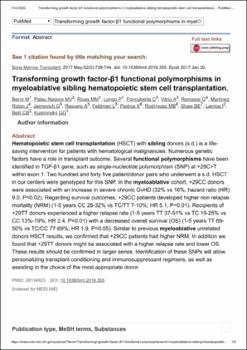| dc.contributor.author | Berro, Mariano. | |
| dc.contributor.author | Palau Nagore, M. V. | |
| dc.contributor.author | Rivas, M. | |
| dc.contributor.author | Longo, Pablo. | |
| dc.contributor.author | Foncuberta, Cecilia. | |
| dc.contributor.author | Vitriú, Adriana. | |
| dc.contributor.author | Remaggi, G. | |
| dc.contributor.author | et al. | |
| dc.date.accessioned | 2020-02-17T18:43:42Z | |
| dc.date.available | 2020-02-17T18:43:42Z | |
| dc.date.issued | 2017-05-01 | |
| dc.identifier.citation | Bone Marrow Transplant. 2017 May;52(5):739-744. | en_US |
| dc.identifier.issn | 0268-3369 | |
| dc.identifier.uri | https://riu.austral.edu.ar/handle/123456789/804 | |
| dc.description.abstract | Hematopoietic stem cell transplantation (HSCT) with sibling donors (s.d.) is a life-saving intervention for patients with hematological malignancies. Numerous genetic factors have a role in transplant outcome. Several functional polymorphisms have been identified in TGF-β1 gene, such as single-nucleotide polymorphism (SNP) at +29C>T within exon 1. Two hundred and forty five patient/donor pairs who underwent a s.d. HSCT in our centers were genotyped for this SNP. In the myeloablative cohort, +29CC donors were associated with an increase in severe chronic GvHD (32% vs 16%, hazard ratio (HR) 9.0, P=0.02). Regarding survival outcomes, +29CC patients developed higher non relapse mortality (NRM) (1-5 years CC 28-32% vs TC/TT 7-10%; HR 5.1, P=0.01). Recipients of +29TT donors experienced a higher relapse rate (1-5 years TT 37-51% vs TC 19-25% vs CC 13%-19%; HR 2.4, P=0.01) with a decreased overall survival (OS) (1-5 years TT 69-50% vs TC/CC 77-69%; HR 1.9, P=0.05). Similar to previous myeloablative unrelated donors HSCT results, we confirmed that +29CC patients had higher NRM. In addition we found that +29TT donors might be associated with a higher relapse rate and lower OS. These results should be confirmed in larger series. Identification of these SNPs will allow personalizing transplant conditioning and immunosuppressant regimens, as well as assisting in the choice of the most appropriate donor. | en_US |
| dc.language.iso | en | en_US |
| dc.publisher | Springer Nature [academic journals on nature.com] | en_US |
| dc.subject | Recurrence | en_US |
| dc.subject | Graft vs Host Disease/genetics | en_US |
| dc.subject | Hematologic Neoplasms/therapy | en_US |
| dc.subject | Transforming Growth Factor beta1/genetics* | en_US |
| dc.title | Transforming growth factor-β1 functional polymorphisms in myeloablative sibling hematopoietic stem cell transplantation | en_US |
| dc.type | Article | en_US |


